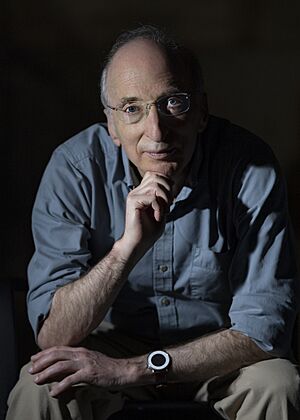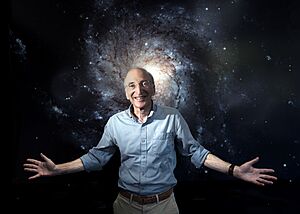Saul Perlmutter facts for kids
Quick facts for kids
Saul Perlmutter
|
|
|---|---|

Perlmutter in 2024
|
|
| Born | September 22, 1959 |
| Education | Harvard University (AB) University of California, Berkeley (PhD) |
| Known for | Accelerating universe / Dark energy |
| Spouse(s) | Laura Nelson (1 child) |
| Relatives | Shira Perlmutter (sister) |
| Awards | Ernest Orlando Lawrence Award (2002) Shaw Prize in Astronomy (2006) Gruber Prize in Cosmology (2007) Nobel Prize in Physics (2011) Breakthrough Prize in Fundamental Physics (2015) |
| Scientific career | |
| Fields | Physics |
| Institutions | University of California, Berkeley/Lawrence Berkeley National Laboratory |
| Thesis | An Astrometric Search for a Stellar Companion to the Sun (1986) |
| Doctoral advisor | Richard A. Muller |
Saul Perlmutter (born September 22, 1959) is an American astrophysicist. He is a professor of physics at the University of California, Berkeley. He also leads the International Supernova Cosmology Project at the Lawrence Berkeley National Laboratory.
Perlmutter is famous for a huge discovery about our universe. He shared the 2011 Nobel Prize in Physics with Brian P. Schmidt and Adam Riess. They found evidence that the expansion of the universe is speeding up. This amazing discovery helped scientists learn more about something called Dark energy. Since 2021, he has been part of the President’s Council of Advisors on Science and Technology (PCAST).
Contents
Early Life and Education
Saul Perlmutter was born in 1959. His parents were both professors. His mother, Felice Perlmutter, taught social administration. His father, Daniel Perlmutter, taught chemical engineering. Saul grew up in Philadelphia, Pennsylvania.
He attended Quaker schools for his elementary and high school years. He then went to Harvard University, where he earned a degree in physics in 1981. Later, he received his PhD in physics from the University of California, Berkeley in 1986. For his PhD, Perlmutter built a special automated telescope. He used it to search for a possible "companion star" to our Sun. At the same time, he also used it to look for supernovae. This work eventually led him to his Nobel Prize-winning research.
Discovering the Accelerating Universe
Saul Perlmutter leads a group called the Supernova Cosmology Project. This team, along with another group called the High-z Supernova Search Team, made a groundbreaking discovery. They found evidence that the universe's expansion is speeding up. They did this by studying special star explosions called Type Ia supernovae.
What are Type Ia Supernovae?
A Type Ia supernova happens when a small, dense star called a white dwarf star explodes. This explosion occurs when the white dwarf pulls too much material from a nearby companion star. Scientists believe these explosions always happen in a very similar way. This means they all have about the same brightness when they explode.
Scientists call these supernovae "standard candles." Imagine a light bulb that you know is always 100 watts. If you see it from far away, and it looks dim, you know it must be very far. If it looks bright, it's closer. Similarly, by measuring how bright a Type Ia supernova appears from Earth, scientists can figure out how far away it is.
How the Discovery Was Made
By comparing the distance to these supernovae with how fast they were moving away (called redshift), the teams made an important observation. They found that distant supernovae were moving away faster than expected. This meant that the universe's expansion must have sped up over billions of years.
Both teams published their findings around the same time. Their conclusions were quickly accepted by other scientists. This discovery changed how we understand the universe. It also led to a lot more research into dark energy. Dark energy is a mysterious force that scientists think is causing the universe to expand faster and faster. For this incredible work, Perlmutter, Riess, and Schmidt were awarded the 2011 Nobel Prize in Physics.
Ongoing Research
Perlmutter is also involved in other important projects. He is a lead scientist for the Supernova/Acceleration Probe project. This project aims to build a satellite to study more supernovae. The goal is to measure the universe's acceleration even more precisely. He also helps with the Berkeley Earth Surface Temperature project. This group works to better understand global warming by analyzing climate data.
Awards and Recognition
Saul Perlmutter has received many awards for his scientific contributions.
- In 2002, he won the Department of Energy's E. O. Lawrence Award in Physics.
- In 2006, he shared the Shaw Prize in Astronomy with Adam Riess and Brian P. Schmidt.
- In 2007, Perlmutter and his team shared the Gruber Prize in Cosmology with Schmidt and the High-Z Team. This award recognized their discovery of the universe's accelerating expansion.
- In 2011, he shared the 2011 Nobel Prize in Physics with Riess and Schmidt. This is one of the highest honors a scientist can receive.
- In 2015, Perlmutter, Schmidt, Riess, and their teams shared the Breakthrough Prize in Fundamental Physics.
A powerful supercomputer at the Lawrence Berkeley National Laboratory is named Perlmutter in his honor.

Family Life
Saul Perlmutter is married to Laura Nelson, who is an anthropologist. They have one daughter named Noa. He also has two sisters: Shira Perlmutter, who is an attorney, and Tova Perlmutter, who works as a nonprofit executive.
See also
 In Spanish: Saul Perlmutter para niños
In Spanish: Saul Perlmutter para niños
- Cosmological constant
- Dark energy
- Dark matter



